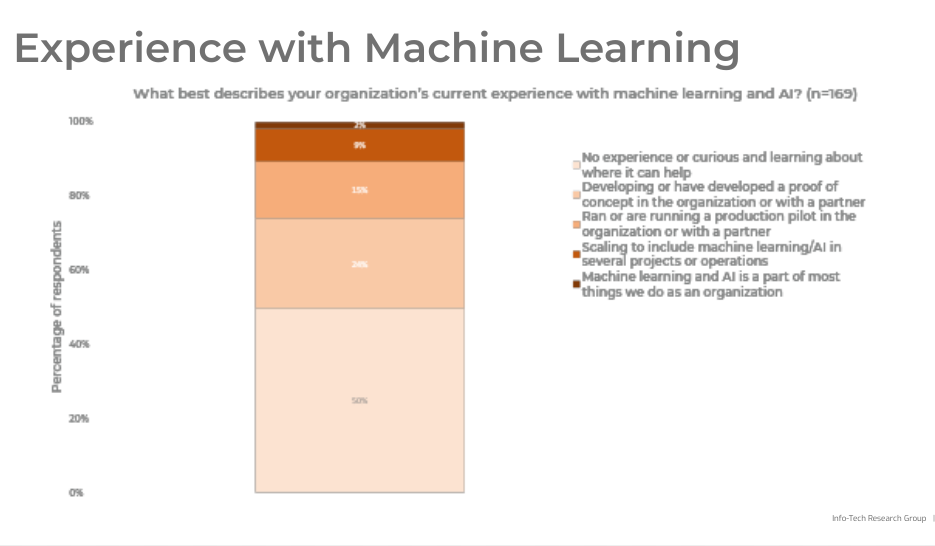Organizations haven’t been able to capitalize on the exponential growth in unstructured data in recent years despite the growth of machine learning, according to the latest research from Info-Tech Research Group.
When it comes to the strategic use of machine learning, a quarter of respondents in Info-Tech’s latest tech trends report claim they won’t be mature enough for at least another four years.
Thirty-one per cent expect at least another year before they can hit the ground running. Just under 15 per cent claim, they’re mature enough today to use machine learning to actually augment business. Out of the more than 200 global survey respondents, most of whom work in IT as a manager or director, 59 of them were from Canada.
It was a bit surprising to hear that technology that has been available for many years is still failing to be turned into a transformational force within organizations, according to Brian Jackson, Info-Tech’s research director for CIO, strategy, and digital transformation.

“The technology is very available now,” Jackson said in an interview. “And we are seeing some organizations use it to build chatbots and other tools to automate customer service.”
But Jackson says it’s a bit alarming to see such a lack of innovation around the use of machine learning outside the startup scene.
“It’s like when people in the year 2000 thinking ‘oh, the internet. I don’t think that’s going to be a big deal,'” he explained.
It reflects a lack of maturity plaguing most IT departments. Only six per cent of survey respondents felt their IT department was mature enough to drive change across the business.
Even with more than 70 per cent of survey respondents noting AI and machine learning will be “very important” over the next five years, only 14 per cent felt their IT was ready to expand the business. Most organizations feel that IT is “optimizing” the business, while 34 per cent view IT as a support mechanism.
A prime example
The streetwear collection business is tough. Getting your own collection off the ground, combined with having to source out designers, pattern cutters and merchandisers – you’re probably looking down the barrel of a six to eight-month process.
Toronto startup Urbancoolab is an AI-powered fashion design platform designed to reduce the headaches associated with that process.
Info-Tech cited the startup in its research as a prime example of AI and machine learning running at the top of the value stream. The research firm went as far as to say the startup is “reinventing a business category.” It’s tough to argue with the results.
Since 2020, Urbancoolab has worked with 30 celebrity artists to launch commercial designs. The research paper highlights how the startup can take a new design to market on its e-commerce site within 24 hours.
Urbancoolab can find patterns in unstructured data in ways that humans can’t, providing new designs rapidly. It can also be used to help confirm which designs will find the most market success.
This lightning-fast turnaround is a big deal, but larger businesses playing in the same arena are simply not as nimble.
“Many large companies lag behind disruptive first movers because they adhere to legacy processes and technology stacks,” Info-Tech noted. “That organizational structure was created long before AI’s emergence, so applying AI in a meaningful way is difficult. There’s also a scarcity of true AI talent available on the market.”
Uncertainties
The untapped potential of AI and machine learning is obvious, but so are some uncertainties. Machine learning algorithms are only as good as the data used to train them. If the algorithms running underneath your datasets’ hood are limited or flawed, that’s bad news for the company.
Most companies are in no position to hire a skilled AI scientist, making talent really hard to come by.
Combine that with the ongoing privacy concerns related to machine learning algorithms touching customer or employee data, and businesses face various challenges and uncertainties that make that leap from IT supporting the business to IT being part of the business tough.
Jackon says channel partners have an obvious opening to address these gaps.
“Modern channel providers should look at themselves as the central service that your customers can rely upon to transform their business,” he explained. “We need companies that are able to look outside themselves and look at opportunities to inject innovative new ideas by working with other companies in the same industry.”
Info-Tech hosted a webinar recently going over data from its trends report. An on-demand link can be found here.
